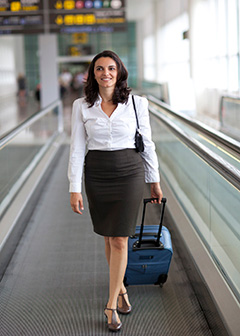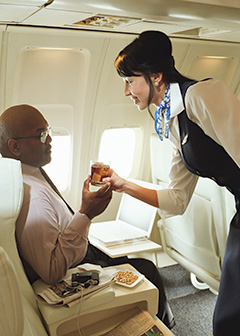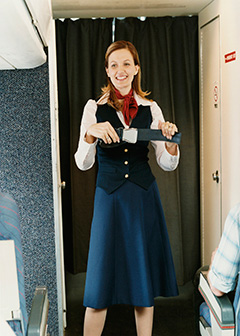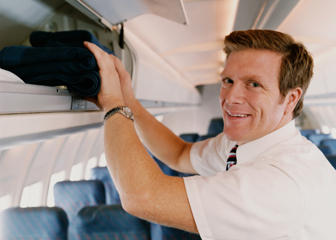
Flight attendants spend a good deal of time away from home.
Flight attendants receive initial training from their employer and must be certified by the Federal Aviation Administration (FAA). A high school diploma or equivalent is required, but airlines increasingly prefer to hire applicants who have a college degree.
Education and Training
A high school diploma or GED is the minimum educational requirement for becoming a flight attendant. However, airlines increasingly prefer to hire applicants who have a college degree. Applicants with a degree in hospitality, tourism, public relations, or communications may have an advantage over others. Most airlines also require 1 to 2 years of customer-service experience. Those who work on international flights may have to speak a foreign language fluently in addition to English.
Applicants must be at least 18 years old and eligible to work in the United States. Applicants also should have a valid passport and are required to pass a background check.
Airlines also have physical requirements. For example, flight attendants must be a certain height to reach overhead bins, and most airlines prefer candidates with weight proportionate to height. Flight attendants must be in excellent health, and a medical evaluation is required.
Once a flight attendant is hired, airline companies provide the worker with initial training, ranging from 3 to 6 weeks. The training usually takes place at the airline’s flight training center and is required for Federal Aviation Administration (FAA) certification.
Trainees learn emergency procedures such as evacuating an airplane, operating emergency equipment, and administering first aid. They also receive specific instruction on flight regulations, company operations, and job duties.
Toward the end of the training, students go on practice flights. They must successfully complete the training to keep a job with the airline. Once they have passed initial training, new flight attendants receive the FAA Certificate of Demonstrated Proficiency. To maintain their certification, flight attendants must take periodic retraining throughout their career.
Certification
All flight attendants must be certified by the FAA. To become certified, flight attendants must complete their employer’s initial training program and pass a proficiency check. Because flight attendants are certified for a specific type of aircraft, they must take new training for each type of aircraft on which they are to work to maintain their certification.
Advancement
After completing initial training, new flight attendants are placed on call, also known as reserve status. While on reserve, attendants must be able to report to the airport on short notice because they are often called on to staff extra flights and fill in for other crewmembers.
New attendants usually remain on reserve for at least 1 year, but in some cities attendants may be on reserve for several years. After a few years, flight attendants gain enough experience to bid on monthly assignments. Because assignments are based on seniority, the most preferred routes go to the most experienced attendants.
Career advancement is based on seniority. Senior flight attendants exercise the most control over route assignments; therefore, they can often choose how much time to spend away from home. On international flights, senior attendants often oversee the work of other attendants. Senior attendants may be promoted to management positions in which they are responsible for recruiting, instructing, and scheduling.
Important Qualities
Attentiveness. Flight attendants must be aware of passengers’ needs to ensure a pleasant travel experience.
Communication skills. Flight attendants should speak clearly and interact comfortably with passengers.
Customer-service skills. Flight attendants should have poise, tact, and resourcefulness to handle stressful situations and meet passengers' needs.
Listening skills. To fully meet passengers' needs, attendants must be able to give their full attention to the passengers, ask appropriate questions of them, and answer their questions politely.
Neat appearance. Because airlines usually have appearance requirements, applicants should not have visible tattoos, body piercings, or unusual hairstyle or makeup.
Proper vision. Flight attendants must have vision that is correctable to at least 20/40.







